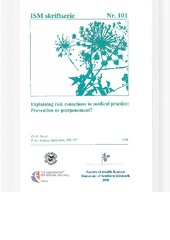Explaining risk reductions in medical practice : prevention or postponement?
Permanent lenke
https://hdl.handle.net/10037/25963Dato
2008Type
Doctoral thesisDoktorgradsavhandling
Forfatter
Halvorsen, Peder AndreasSammendrag
Diagnosis, treatment and follow up of risk conditions such as
hypercholesterolemia and osteoporosis are prominent tasks of contemporary medical practice.
The aim is to prevent, or at least postpone the onset of adverse health outcomes such as
angina pectoris, heart attacks, strokes and fractures. Dealing with risks involves decision
making under uncertainty. For patients to be able to engage meaningfully in shared decision
making, benefits of risk reducing interventions must be communicated in easily
comprehensible ways. From randomised controlled trials effectiveness of such interventions
may be estimated and conveyed in traditional formats such as relative risk reduction, absolute
risk reduction or number needed to treat (NNT), Alternatively, to account for the time
dimension, prolongation of (disease free) life or, equivalently, postponement of adverse
events may be used. There is ample evidence that the different formats for risk reductions
yield different decisions, i.e. framing effects. The most consistent finding is that decision
makers are more inclined to accept interventions when risk reductions are explained in
relative rather than absolute terms. To some extent decisions on hypothetical drug therapies
by NNT and postponement of adverse outcomes have been studied empirically. It appears that
lay people are insensitive to effect size in terms of NNT but sensitive to the length of
postponement. The aim of this Ph. D. study was to explore how physicians and lay people
understand and respond to the concepts of NNT and postponement when making decisions
about risk reducing interventions against cardiovascular diseases and osteoporosis.
Forlag
Universitetet i TromsøUniversity of Tromsø
Serie
ISM skriftserie Nr. 101, 2008Metadata
Vis full innførselSamlinger
- ISM skriftserie [161]
Copyright 2008 The Author(s)


 English
English norsk
norsk